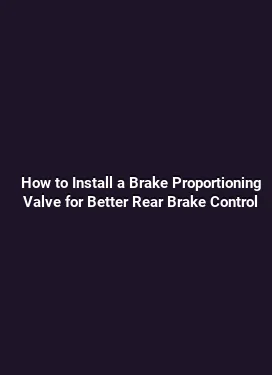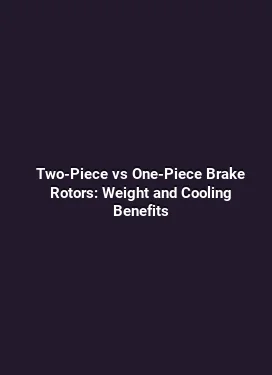How to Upgrade Brake Master Cylinder for Bigger Brake Caliper Setup
Understanding the Brake System Basics and the Role of the Master Cylinder

The brake system in modern vehicles relies on a well-orchestrated hydraulic network. At the heart of this system is the master cylinder, a component that translates pedal force into hydraulic pressure. When the brake pedal is pressed, a piston inside the master cylinder pressurizes brake fluid, which travels through the lines to the brake calipers or wheel cylinders. The resulting clamping force on the brake pads or shoes slows the vehicle. Upgrading to bigger brake calipers often requires re-evaluating the master cylinder because larger calipers demand higher hydraulic pressure and a different flow profile to achieve a balanced and predictable braking response.
In practical terms, increasing caliper size without addressing the master cylinder can lead to a soft pedal, inconsistent braking, or reduced brake bite. The master cylinder’s bore diameter, piston count, and overall volume determine how quickly fluid is moved and how much pressure is generated for a given pedal effort. A setup that pairs oversized calipers with an undersized master cylinder can create a mismatch between pedal travel and braking performance, compromising safety and control.
Assessing Caliper and Rotor Compatibility with the Master Cylinder
Before selecting a replacement master cylinder, establish how your intended caliper upgrade will interact with the braking system. Larger calipers typically require more hydraulic volume and may demand higher pressure to achieve the same caliper clamping force. Start by collecting essential specifications: the caliper bore size, piston count, rotor diameter, and the current master cylinder bore. With this data, you can calculate the relative hydraulic ratio, which is a function of pedal ratio, master cylinder bore, and caliper piston area. This ratio helps predict whether the stock master cylinder can produce sufficient pressure and volume for the larger calipers.
Another critical factor is brake fluid dynamics: longer or more complex lines add resistance, and the system’s overall volume increases. If the new calipers are significantly larger, a master cylinder with a bigger bore or an additional master cylinder (dual master cylinder setups or tandem systems) may be necessary to maintain a firm pedal and reliable modulation. Always verify compatibility with the vehicle’s brake pedal feel, ABS modulator, and steering rack integration to avoid unintended interactions with the ABS or stability control systems.
Choosing a Master Cylinder Replacement for Bigger Calipers
The selection process begins with a clear understanding of the target caliper size and the vehicle’s brake balance. A larger bore master cylinder can deliver higher pressure for a given pedal input, but it reduces pedal travel, which may affect modulation. Conversely, a smaller bore may increase pedal travel but limit pressure, which can be problematic with oversized calipers. In some cases, a dual master cylinder setup designed specifically for performance street or track use can provide the best compromise between feel and stopping power.
Practical considerations include the brake system architecture (single-circuit vs. dual-circuit, front/rear bias), mounting compatibility, reservoir capacity, and the presence of an integrated proportioning valve. When upgrading, it is common to upgrade the entire hydraulic assembly in a coordinated way: master cylinder, brake lines or stainless steel braided lines, and the calipers themselves. This holistic approach helps maintain predictable pedal feel and consistent braking across a range of temperatures and driving conditions.
Hydraulic Calculations and Fluid Considerations
Hydraulic calculations are essential to estimate whether the new master cylinder will deliver adequate pressure and volume. A practical approach is to compare the target caliper piston area and the master cylinder bore area. The pressure generated in the system is related to the ratio of the master cylinder bore area to the caliper piston area, as well as the fluid viscosity and line resistance. If the calipers have a larger total piston area, a master cylinder with a proportionally larger bore can help maintain acceptable pressure.
Fluid considerations matter too. Brake fluid is incompressible, but its properties shift with temperature. In high-performance or track environments, a fluid with a higher boiling point and good chemical compatibility with the system’s seals is desirable. Bleeding procedures may need to be adjusted for larger volumes and longer line runs to ensure there are no air pockets that could compromise pedal firmness. When selecting fluid, verify compatibility with ABS modulators and any metallic or composite components in the system to prevent corrosion or seal swelling.
Installation Process: Steps for Upgrading the Master Cylinder
The installation sequence generally begins with safety preparations: disconnect the battery, relieve pressure by bleeding the system, and support the vehicle securely. Remove the existing master cylinder, noting the mounting points and the connection to the brake booster. A common upgrade path involves selecting a master cylinder with the same mounting pattern and a compatible pushrod length. In some vehicles, adapters or modifications to the pushrod or pedal linkage are required to achieve the correct pedal ratio and initial bite point.
With the new master cylinder in hand, install it following the manufacturer’s torque specifications for mounting bolts and ensure the pushrod is correctly positioned against the pedal assembly. Attach reservoir hoses securely, being mindful of orientation to prevent air entrapment. Then bleed the system starting from the calipers furthest from the master cylinder, using a two-person bleed method or a vacuum/pressure bleeder to remove air efficiently. Refill the reservoir with fresh fluid to the recommended level and check for leaks at all fittings and seals. A careful, methodical bleed is crucial when larger calipers and increased fluid volume are introduced, as residual air can lead to a soft pedal or inconsistent braking.
Bleeding and Brake Fluid Maintenance for New Calipers
After installation, a thorough bleed is essential to purge air from the extended hydraulic network. Begin with the longest line to the furthest caliper and proceed systematically to the closest. A sluggish bleed or persistent air pockets usually indicate line resistance, improper fitting, or partially closed bleed screws. In addition to the initial bleed, perform a second bleed after a short drive to ensure any micro air pockets dislodge under dynamic braking conditions.
Maintenance intervals for brake fluid depend on usage, climate, and driving style. Consider replacing the fluid every 1 to 2 years or sooner in extreme conditions. Monitor fluid color and moisture content; darker fluid indicates contamination or aging. If the system uses synthetic or racing fluids, verify compatibility with the master cylinder seals and ensure the bleed procedure aligns with the chosen fluid type to prevent seal swelling or diminished performance.
Common Upgrade Paths and Practical Tradeoffs
Several practical paths exist for upgrading to bigger calipers, with the master cylinder chosen to maintain a balanced system. Options include selecting a higher-capacity stock replacement that matches the caliper’s mechanical advantage, or adopting a performance-oriented master cylinder designed for larger caliper applications. Each path has tradeoffs: pedal feel, boot resistance, and hydraulic balance across front and rear axles. The goal is a pedal that remains firm under load, with predictable bite and fade resistance during repeated braking cycles.
From a dynamics perspective, the aim is consistency rather than mere peak force. A well-maired system delivers linear response, stable modulation, and reliable thermal performance. If ABS or electronic brake-force distribution appears inconsistent after upgrades, re-evaluating line routing, caliper alignment, and reservoir pressures becomes necessary. Real-world testing—trail braking, threshold braking, and progressive stops—helps confirm the practical outcomes of the upgrade.
Safety, Legal Considerations, and Quality Assurance
Any brake system modification carries safety implications. Ensure upgraded components meet or exceed OEM specifications and are compatible with the vehicle’s safety systems. Use high-quality fittings, hoses, and seals rated for the intended pressure range. During testing, avoid aggressive stops in traffic; perform controlled tests on closed courses or designated test areas to validate performance and reliability under varying temperatures and speeds.
Keep records of all parts, torque specs, bleed sequences, and fluid type used during the upgrade. This documentation assists maintenance, future inspections, and potential warranty considerations. If in doubt, consult with qualified technicians who specialize in performance braking systems to verify the upgrade plan aligns with vehicle dynamics and local regulations.
Testing, Tuning, and Fine-Tuning Your Braking System
Post-install testing should include a ramp of gradual braking forces to map pedal travel to braking power. Monitor pedal feel at idle, during steady braking, and under high-speed deceleration. If the pedal remains spongy or the stopping distance seems excessive, re-check the bleeding quality, line routing, and the master cylinder’s compatibility with the new calipers. Tuning may involve minor adjustments to the pedal ratio through pushrod length or pedal box settings and confirming the front-rear brake bias is appropriate for the vehicle’s weight distribution and axle characteristics.
In performance environments, consider complementary upgrades such as vented rotors, optimized caliper positioning, and high-temperature brake pads that match the upgraded hydraulic system. A cohesive package ensures the system delivers reliable performance during repeated high-speed stops without excessive fade or instability.
Long-Term Care, Maintenance, and Monitoring
Over the long term, inspect all hydraulic connections for signs of fluid leakage, corrosion, or wear. Periodic checks of reservoir level, cap seal integrity, and cap venting are important to maintain consistent pressure, especially in vehicles that operate in extreme temperatures or dusty environments. Monitor brake fluid color and replace it at recommended intervals to prevent moisture-induced boil-off and corrosion in metal components. Routine inspections should also include a check for brake pedal feel, ABS engagement points, and any unusual noise or vibration that may indicate a misalignment or binding in the caliper or lines.
Real-World Scenarios: When an Upgrade Becomes Necessary
Owners of performance-oriented vehicles, track enthusiasts, or those who routinely tow heavy loads may encounter scenarios where the stock master cylinder simply cannot sustain the demands of bigger calipers. In these cases, upgrading the master cylinder is a prudent step to preserve braking predictability, fade resistance, and stopping power. By approaching the upgrade as a system-wide enhancement rather than an isolated swap, the overall braking performance becomes more coherent, enabling safer and more confident driving experiences across diverse conditions.
Important Considerations for Installation Planning

Before purchasing parts, map out the entire upgrade plan, including compatible master cylinder options, line routing, and potential harness or sensor considerations for modern ABS/EBD systems. Create a checklist that covers mounting compatibility, pushrod geometry, reservoir capacity, and bleed procedure specifics. This proactive approach reduces the risk of incompatibilities and ensures a smoother installation process with predictable outcomes.
Field Testing and Verification Methods
During field tests, implement controlled stop tests on smooth surfaces to establish baseline metrics for pedal travel, stopping distance, and brake modulation. Compare the results against the vehicle’s original braking performance and adjust as needed. Document every test, including ambient temperature, road surface, speed, and braking force, to build a data set that informs ongoing maintenance and potential future upgrades.
Conclusion: A Balanced, Informed Upgrade Path
Upgrading a brake master cylinder to accommodate bigger calipers is a holistic endeavor that requires careful consideration of hydraulic balance, compatibility, and safe operating limits. By understanding the interplay between master cylinder bore size, caliper piston area, fluid dynamics, and pedal feel, enthusiasts can achieve a coherent braking experience that preserves control and safety. Through meticulous installation, thorough bleeding, and thoughtful testing, the upgraded system delivers reliable, linear response that supports confident driving across a range of conditions.






